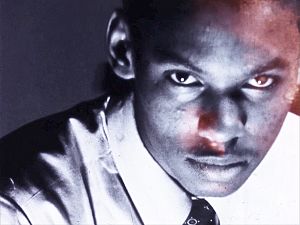Edward Owens (filmmaker) facts for kids
Edward Owens (1949–2010) was an African-American filmmaker. He was active in the New American Cinema movement of the 1960s. Owens was from Chicago. He is best known for his experimental films Remembrance: A Portrait Study (1967) and Private Imaginings and Narrative Facts (1968–70).
Contents
Edward Owens' Early Life and Influences
As a teenager, Edward Owens lived on Chicago's South Side. He spent his free time making films with an 8mm camera. Later, he studied painting and sculpture. He went to the School of the Art Institute of Chicago (SAIC).
At SAIC, Owens met Gregory Markopoulos. Markopoulos was an experimental filmmaker. He had started the school's film program. Markopoulos was very impressed with Owens' films. He encouraged Owens to move to New York City. Owens moved there in 1966.
In New York, Markopoulos became a guide for Owens. He introduced Owens to important people in film and art. These included Andy Warhol and Marie Menken. After making several films, Owens moved back to Chicago in 1971.
Today, four of Owens' films still exist. He made three of them when he was 18 years old. These films helped him join New York's underground film community. A fourth film, "Autre Fois J'ai Aime Une Femme" (1966), was also saved. Experts used special digital technology to preserve all four films. This was done by MM Serra of The Film-Makers' Cooperative.
Edward Owens' Filmmaking Career
Owens' Unique Film Style
Edward Owens' films look like paintings. They also feel very personal. His films from 1966 to 1970 showed his growing skill. He was first inspired by Markopoulos's style. But Owens soon created his own unique look.
Owens' films are known for their dramatic lighting. He also used a technique called superimposition. This means showing several images on top of each other. His film Tomorrow's Promise (1967) tells a story about feeling empty. Owens made this film when he was only 18. It was inspired by Markopoulos's Twice a Man (1963).
Owens used special lighting and layered images. He also changed the way images appeared and their colors. These techniques helped him share his personal life in his films.
His film Remembrance: A Portrait Study (1967) is a portrait of his mother, Mildred. It also features her friends, Irene Collins and Nettie Thomas. In the film, each person is shown with a song. "Running Wild" by Marilyn Monroe plays for Nettie. "All Cried Out" by Dusty Springfield plays for Mildred.
Private Imaginings and Narrative Facts (1968–70) focuses more on Owens' mother. It layers her image with pictures from magazines. It also uses other images from pop culture.
Edward Owens' Filmography
- Autrefois J'ai aime une femme (1966)
- Tomorrow's Promise (1967)
- Remembrance: A Portrait Study (1967)
- Private Imaginings and Narrative Facts (1968–70)
Edward Owens' Later Life and Death
In 1971, Owens left New York. He returned to his home state of Illinois. He passed away at age 60. He did not complete another film after returning to Illinois.
Recognition for Edward Owens' Films
Edward Owens' film Remembrance: A Portrait Study was recognized early on. Parker Tyler listed it as an important experimental film of 1968. This was in his book Underground Film: A Critical History (1969). However, most people did not know about Owens' work until the 2000s. His films became known through The Film-Makers' Cooperative in New York City.
In 2006, Ronald Gregg included Owens' films in a screening series. This was at the University of Chicago. The series was called "Beyond Warhol, Smith, and Anger: Recovering the Significance of Postwar Queer Underground Cinema, 1950-1968". In 2009, film programmer Ed Halter began to promote Owens' work. He helped rediscover and share Owens' films. He also interviewed Owens to understand his creative ideas.
In June 2016, Owens' films were digitally preserved. The Film-Makers' Cooperative worked with IndieCollect. They made high-quality digital copies of all four films. This allowed Owens' films to be seen around the world. They became available through online video programs.
In 2017, curators Mark Godfrey and Zoé Whitley included Owens' films in an art show. It was called Soul of a Nation: Art In the Age of Black Power. They said Owens' films were early examples of experimental filmmakers focusing on Black life.
Owens' films have been shown at many places. These include the Gene Siskel Film Center in Chicago (2018). They were also shown at the LA Film Forum (2019). The Museum of Modern Art showed them in 2019. The Maysles Documentary Center also screened his films in 2020.


